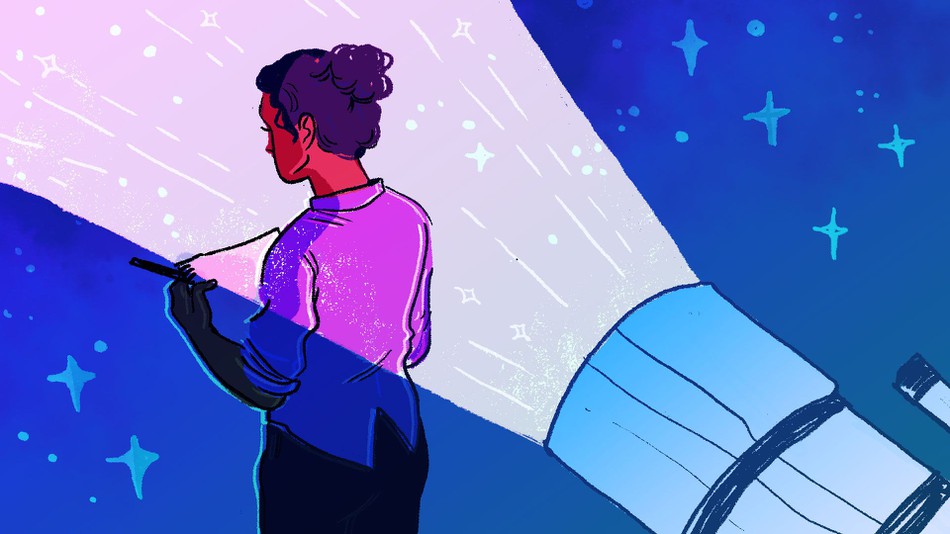By Miriam Kramer
Mashable, July 11, 2017 —
/https%3A%2F%2Fblueprint-api-production.s3.amazonaws.com%2Fuploads%2Fcard%2Fimage%2F531635%2Fec20895a-637c-4059-a5e1-dbbb54604fe2.jpg)
IMAGE: MASHABLE/VICKY LETA
For years, women in astronomy and planetary science have whispered their stories of gendered and racial harassment at the hands of colleagues and students, painting an anecdotal picture of a field that is hostile toward women, particularly women of color.
Even in the wake of highly publicized incidents of discrimination in these fields, the extent of harassment has been unquantified.
But now, thanks to newly published research, that picture is becoming clearer, and the findings paint a disturbing picture of experiences women face in planetary science and astronomy.
The new study, which is based on survey data collected from 2011 to 2015, shows that 39 percent of the 474 astronomers and planetary scientists surveyed reported that they have been verbally harassed in their current jobs, and 9 percent said they have been physically harassed. Nearly 67 percent of respondents identified as female, according to the study, which is a much higher percentage than national samples of people in space science.
Of particular note in the research — published in the Journal of Geophysical Research: Planets — is the higher incidence of harassment among women of color.
“In this sample, in nearly every significant finding, women of color experienced the highest rates of negative workplace experiences, including harassment and assault,” the study says.
The survey found that “40 percent of women of color reported feeling unsafe in the workplace as a result of their gender or sex, and 28 percent of women of color reported feeling unsafe as a result of their race.”
‘Barrier breaking women’
“This is the first study that I know of which sought to study women in a scientific field broadly and returned results that highlighted specifically the experiences of women of color,” Chanda Prescod-Weinstein, a theoretical physicist who was not an author of the study, said via email.
“In that sense, I think it is barrier breaking work on barrier breaking women.”
Women of color in science on the whole are breaking barriers.
Black women made up just 6.6 percent of the science and engineering workforce in 2013, according to National Science Foundation data, with Hispanic women accounting for 6.9 percent of that workforce and Asian women making up 17.7 percent. By comparison, white women made up 66.9 percent of that workforce in 2013.

IMAGE: NSF/SESTAT
The new study also shows that 18 percent of women of color surveyed didn’t go to conferences, meetings, or other professional events because “they did not feel safe attending.” This is particularly significant considering that attending such events can be essential to advancing one’s career.Meetings and conferences are a main source of networking for researchers from around the country, so skipping these events can represent a huge loss of opportunity, especially for young researchers.
“My hope is that everyone will take away from this new study that it’s on all of us. It’s all of our responsibilities to try to create safe, inclusive, welcoming environments and that we’re not doing that right at this moment, particularly for women of color,” study co-author Christina Richey said in an interview.
A very public reckoning
Harassment in astronomy has garnered significant public attention since 2015, when reports came to light that Geoff Marcy — one of the most prominent researchers in the field at the time — sexually harassed students at the University of California, Berkeley.
From there, the floodgates opened, with women telling their stories of harassment publicly on Twitter using hashtags like #AstroSH, and others speaking with media outlets directly.
Stories of the “whisper networks” used by women to communicate information about harassers with one another in an attempt to keep their colleagues and students safe also came to light in that time.
This new study is important, in part, because it shows — with peer-reviewed data — that widely publicized incidents are not isolated.
Prescod-Weinstein, who has written about inequality in the sciences for years, hopes that this study helps others in space science “learn that what women (especially of color) have been telling them is not merely anecdotal but statistically significant.”
“I hope also they consider the impact that these experiences have on our ability to publish and research at competitive rates with our white, male colleagues,” she said.
Richey acknowledges that the new study can be shocking for those who haven’t experienced or witnessed this kind of harassment first-hand, but after that shock wears off, it’s time for action.
Where to go from here
The researchers outlined what could be an ideal approach to addressing gendered and racial harassment in space science.
The study suggests that employers should craft a strict code of conduct, provide mandatory diversity awareness training, and that leaders in the field need to be the ones to model appropriate behavior.
In addition, the study says employers need to take quick and fair action when harassment and assault are reported.
For her part, Prescod-Weinstein doesn’t have much confidence that universities will change their ways when it comes to protecting their faculty.
“I don’t have a lot of faith in the system. The American Astronomical Society and American Physical Society, our professional advocacy groups, still refuse to say the three words, ‘Black Lives Matter,'” Prescod-Weinstein said.
“When they’re afraid of words that are just a statement of fact, how can we be confident that their actions will reflect these facts? And if our advocacy organizations don’t put the pressure on, how can we expect educational institutions that are primarily focused on PR and money to feel the pressure?”
Perhaps the weight of peer-reviewed research bearing down on these universities will up the pressure enough for things to change.











